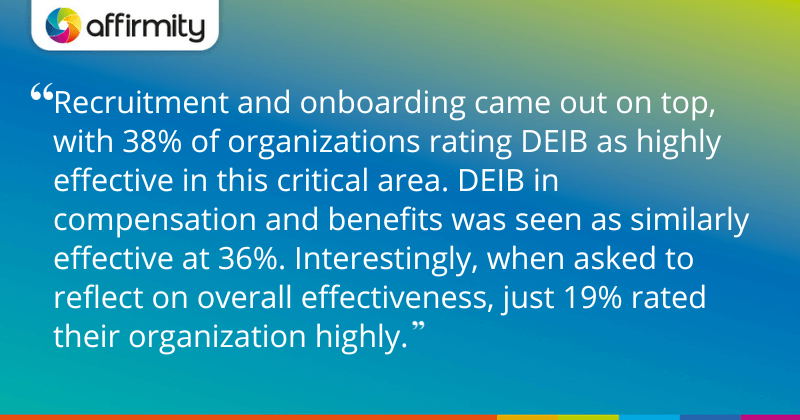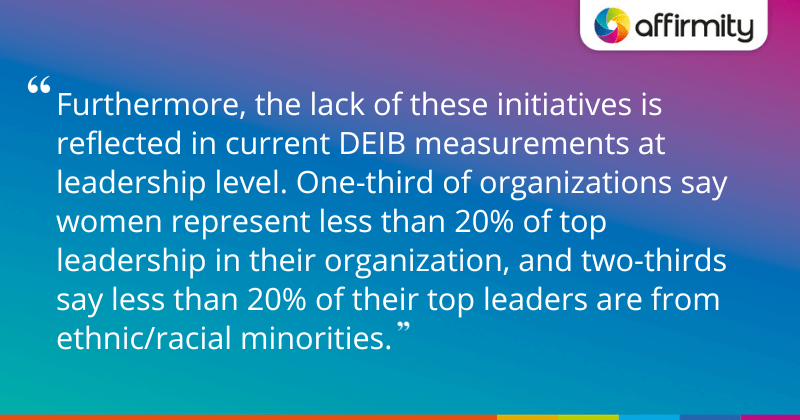The HR Research Institute recently published its annual Future of Diversity, Equity, Inclusion, and Belonging (DEIB) white paper, an Affirmity-sponsored report that provides 60 pages of insight into current DEIB practices. In this blog post, you’ll find highlights from the research, including some of the most interesting stats and observations, all of which reveal the current state of play for DEIB.
1) More Report Respondents Rate Their DEIB Development As “Advanced” or “Expert” Than Ever Before
HR.com’s report has been running since 2018/19, and in this time it has consistently tracked the question “At what stage of development is diversity, equity, inclusion, and belonging within your organization?” The report describes five stages of DEIB maturity (from highest to lowest): Expert, Advanced, Intermediate, Beginning, and Undeveloped, and special attention is usually paid to the number of organizations selecting the highest of these. They are defined as follows:
- Expert:
- DEIB is embedded in the organizational culture, prioritized by the CEO and board members.
- Senior leadership oversees DEIB initiatives.
- DEIB-related analytics are used to address recruiting, retention, succession planning, and other talent-related issues.
- Managers’ performance is evaluated based on DEIB objectives.
- DEIB initiatives are strategic and contribute to the achievement of organizational goals.
- Advanced:
- The organization has a strategic framework that has multiple pillars aligned with its goals.
- DEIB efforts include metrics and setting annual goals for improvement.
- The organization closely follows DEIB at leadership levels.
In this year’s report, 7% rated their organization as “Expert” level, and 21% selected the rating “Advanced”, for a combined share of 28%. This is substantially higher than the 15% who said the same in 2023, though it had previously been as high as 23% in 2020.

2) Recruitment and Onboarding Are the Strongest Areas for Most DEIB Initiatives
One question, apparently new to the report series, provides insight into how specific departments benefit from DEIB initiatives. Respondents were asked, on a ten-point scale, to state how effective their organization’s DEIB initiatives are in certain business areas. The report highlights the upper end of that scale, giving a percentage of those responding with an 8, 9, or 10.
Recruitment and onboarding came out on top, with 38% of organizations rating DEIB as highly effective in this critical area. DEIB in compensation and benefits was seen as similarly effective at 36%. The weakest area on the graph was leadership development, which just 20% considered effective. Interestingly, when asked to reflect on overall effectiveness, just 19% rated their organization highly, though this is up from just 6% in 2023.
LEARN MORE ABOUT AN EMERGING TOPIC IN RECRUITMENT AND ONBOARDING | ‘6 Potential Positives of Using AI for Candidate Selection and Diversity’

3) HR Remains Largely Responsible for DEIB and a Quarter of Organizations Have No DEIB Function
Over half of organizations (52%) delegate the responsibility for DEIB to their HR department in some capacity, either specifically to the Chief HR Officer (18%), the HR department as a whole (18%), or a specific team or person within the HR department (16%).
Organizations are less likely to have DEIB department/committee responsibility (18%) or a specific Chief of DEIB (11%). The Chief Executive Officer is primarily responsible in only 6% of organizations. Furthermore, a later question suggests that 27% of organizations do not have a DEIB department, function, or representative.
Earlier in the life of the report series (2018/19), HR was responsible for DEIB in just 36% of organizations, and it has grown steadily to 52% in the last few years. HR.com’s analysis continues to question delegating responsibility in this way: “DEIB requires a skillset that may be missing from other HR functions, and organizations may be operating with reduced capabilities by failing to have a DEIB department and/or head of DEIB.” The report also notes that larger organizations are more likely to have these independent DEIB functions and lines of responsibility.
MORE ON DELEGATING DE&I RESPONSIBILITIES | ‘How Accountability and Tailored Reporting Make or Break Data-Driven DE&I Management’
4) Organizations Are Primarily Emphasizing DEIB for Cultural and Talent-Related Reasons
When asked what the primary goals of their DEIB initiatives are (aside from increasing diversity, equity, inclusion, and belonging in a general sense), respondents chose:
- Building a culture of trust (70%)
- Removing bias (61%)
- Retaining the right talent (60%)
- Boosting engagement (58%)
- Recruiting the right talent (56%)
- Ensuring fairness (55%)
The least popular answer in the report was “Attaining a higher market share” (10%), though 9% claimed to have no DEIB goals at all.

5) Two-Thirds of Organizations Lack a Mandate to Increase Diversity in Leadership (And Leadership Diversity Reflects This!)
The report found that only 34% of organizations have a mandate to increase diversity in leadership roles, and just 15% have a rating mechanism for their managers’ ability to reach specific DEIB goals. The report highlights having a lack of initiatives to build leadership capacity among under-represented groups as a factor that’s likely to reduce the effectiveness of DEIB programs.
Furthermore, the lack of these initiatives is reflected in current DEIB measurements at leadership level. One-third of organizations say women represent less than 20% of top leadership in their organization, and two-thirds say less than 20% of their top leaders are from ethnic/racial minorities.
6) Organizations That Lead in DEIB Provide a Template for Others to Follow
As always, the report has kept track of the practices and perspectives of organizations with more advanced DEIB programs in order to provide further insight and some recommended best practices. It found that these DEIB leaders are more likely to:
- Offer DEIB-related L&D to all employees
- Operate a larger variety of DEIB-related initiatives
- Use a wider range of DEIB-related metrics to measure progress
- Have one or more leadership development initiatives for the purpose of improving DEIB in leadership
- Believe that DEIB initiatives enhance organizational performance, mission, vision, and values, as well as play a role in strategic planning
LEARN ABOUT ADVANCED DE&I ANALYSIS | ‘How to Use a Climate Survey to Understand and Nurture Diversity, Equity, and Inclusion’
The Future of Diversity, Equity, Inclusion and Belonging 2024: Continue Reading
We’ve just scratched the surface of the insights available in the full 60-page white paper. In addition to further analysis on the issues above, you can expect the full report to also cover important topics such as:
- The extent to which the political and social backlash against DEIB is undermining the effectiveness of initiatives
- The benefits and work arrangements that organizations are using to attract and retain diverse employees
- Whether DEIB today is “all talk and no action”
- The main barriers that teams see to greater DEIB effectiveness
Take a deeper dive into these key trends and more: get your copy of the white paper today or get in touch to learn how we can help advance your DEIB goals.
About the Author
 Joe Valenzuela is a Certified Diversity Professional and recently joined Affirmity as a product visionary and advocate for its DEI software platform and consulting services. He has successfully helped develop, launch and manage DEI journeys within the insurance, legal, tech, and financial services industries using DEI analytics. He also helps clients map DEI data points to ESG “Social” questions to increase their ESG Index Score.
Joe Valenzuela is a Certified Diversity Professional and recently joined Affirmity as a product visionary and advocate for its DEI software platform and consulting services. He has successfully helped develop, launch and manage DEI journeys within the insurance, legal, tech, and financial services industries using DEI analytics. He also helps clients map DEI data points to ESG “Social” questions to increase their ESG Index Score.
